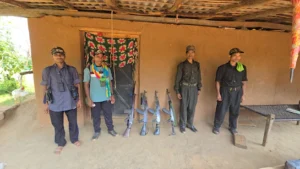Context
Union Home Minister Amit Shah reiterated that the government is determined to eradicate Maoism by next year, urging Maoist cadres to surrender under the “lucrative surrender and rehabilitation policy.”
The article analyses how the CPI (Maoist) movement, once a major internal security challenge, has reached a stage of terminal decline due to effective counterinsurgency measures, leadership losses, and internal disillusionment.

Key Developments
- Structural Weakening of Maoists
- The Central Committee and Politburo of the CPI (Maoist)—its top decision-making bodies—have shrunk drastically.
- In 2004: Around 42 Central Committee members and ~25 Politburo members.
- In 2025: Only 13 Central Committee and 7 Politburo members remain.
- Most surviving leaders are over 60 years old and suffering from age-related illnesses, indicating leadership fatigue.
- The cadre base has dwindled to below 2,000 active members.
- Decline and Loss of Territorial Control
- Maoist dominance peaked in the early 2000s across underdeveloped districts of Andhra Pradesh, Odisha, Chhattisgarh, and Jharkhand.
- Operations such as Greyhounds (AP) and COBRA (CRPF) successfully reclaimed several strongholds.
- The introduction of Commando Battalion for Resolute Action (CoBRA) and District Reserve Guard (DRG) in Chhattisgarh—comprising ex-Maoists and locals—proved decisive.
- Operation Black Forest (2024–25) destroyed major Maoist hideouts in the Karrupate hills, killing senior leaders including Nambala Keshava Rao (Basavaraj).
- Security Forces’ Success
- In the past 18 months, over 430 Maoists, including 45 women operatives, have been killed; 1,450 have surrendered and 1,460 arrested.
- The state’s multi-pronged strategy has:
- Reduced Maoist military capability
- Weakened their ideological base
- Severely disrupted command hierarchy
- Social and Political Factors Behind Decline
- Loss of tribal support: Early Maoist legitimacy rested on representing Adivasi grievances (land alienation, exploitation). Over time, their violence and extortion alienated locals.
- Civil society fatigue: Tribes and villagers—initially sympathetic—have turned away due to atrocities committed by Maoists.
- Better governance and welfare outreach under government schemes in tribal belts have undermined Maoist appeal.
- Internal Crisis of Leadership
- Death or arrest of senior leaders created factionalism and strategic confusion.
- Younger recruits lack ideological grounding and operate mainly for survival.
- Absence of intellectual leadership has reduced the movement to sporadic violence without coherent political purpose.
- Regional Situation
- Chhattisgarh remains the last major bastion of Maoist influence.
- States like West Bengal, Bihar, Andhra Pradesh, and Odisha have largely neutralized the insurgency.
- In Telangana, only small splinter groups survive, operating with limited capability.




